#dungeon23
Explore tagged Tumblr posts
Text
ONE DAY LEFT for THE 55
If you want a cool cyberpunk megablock tower to populate your own dystopian city, or just need some extra characters or complications for your cyberpunk TTRPG, now is the time to grab a copy.
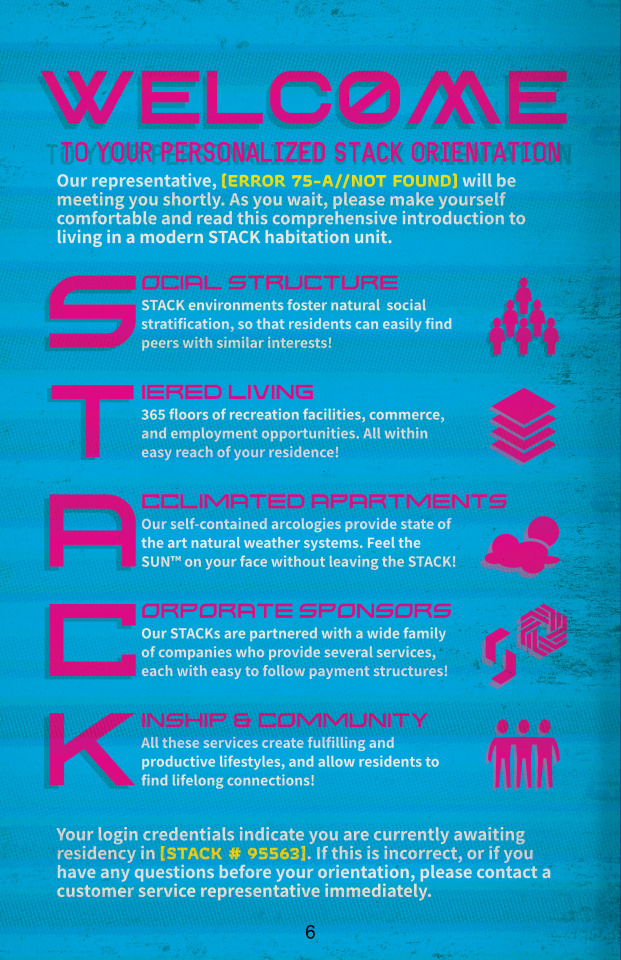
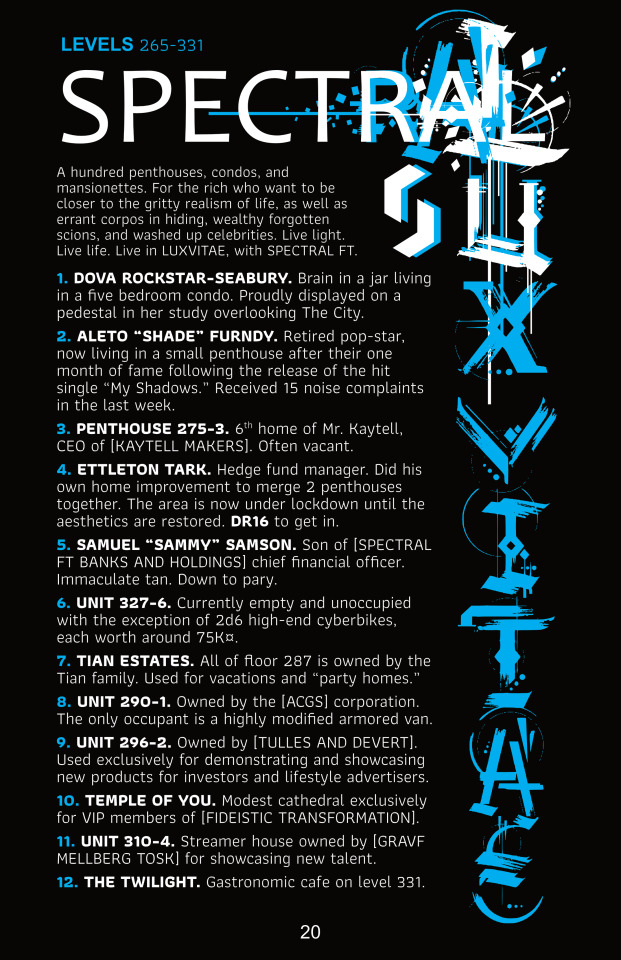
Back today and get:
Early access to THE 55
Digital downloads
Physical zines shipping worldwide
Notebook pages from the original #dungeon23 draft
Poster art of the cover.
Check it out. Spread the word. Tomorrow I can talk about other stuff :P
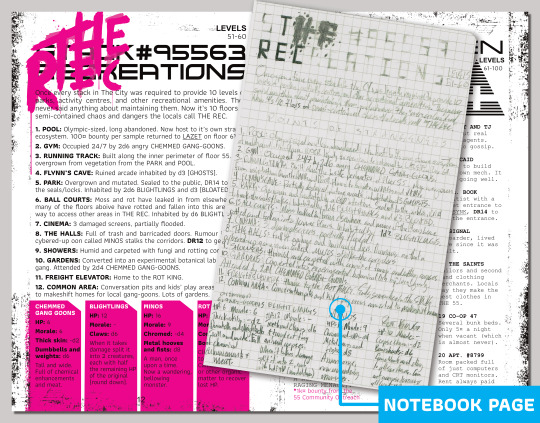
#indie ttrpg#ttrpg#rpg#crowdfunding#tabletop#cy borg#cyberpunk#dungeon23#cyberpunk rpg#cyberpunk art#cyberpunk aesthetic
45 notes
·
View notes
Text

Brinefathom Caves Level 6, Week 8
6.76: The False Demilich
6.77: The Lake of Tears
6.78: The Blood Basin: Basin stained with old dried blood. Refilling it (which requires draining a medium creature or equivalent) causes the wall the basin is on to swivel, opening a one-way secret door for one dungeon turn. Empty.
6.79: The Hot and Cold Doors: Southern half of the room is bitingly cold, northern is baking hot. Metal slab doors only stay open as long as they maintain the opposite temp (hot for southern and cold for northern). Empty.
6.80: The Heavy Weapons
6.81: The Infernal Escape
6.82: The Hanging Doors: Walls painted with frescoes of hanged pirates. Gibbet extends between northern and western doors, which have no keyhole or handles. If a corpse is hung from the gibbet’s noose (regardless of whether it was killed by the noose or not) the door that it faces opens. Empty.
6.83: The Truthful Guards
6.84: The Frozen Leviathan
6.85: The Truthful Dead: Floor carved with runes: zone of truth on entire room. Corpses of two anchor devils who appear to have frozen to death. Empty.
6.86: The Wall of Masks: Northern wall completely covered in devil masks that laugh and jeer when mortals approach them. Ten of the masks conceal buttons, which, if pressed in the correct sequence, open the secret door to 6.87. Only Ukarith knows the correct order, (1-6-8-5-4-9-7-10-3-2) but it can also be gleaned from touching the ice in 6.84. A creature who presses the buttons in the incorrect order must succeed at a Wisdom saving throw or fall prone and become incapacitated and unable to stand for one minute as they’re wracked with laughter. Empty.
6.87: Ukarith's Secret Shrine
6.88: The Tree of Hearts' Desire
(Non-key rambling under cut)
Aaaaand that's a wrap for 2024! Thank you to everyone who supported this project, especially @aranov, @bcswowbagger Decoder13 (no tumblr) @fishdavidson, @lunaofthemiste, @skinslip, @spewagepipe. Your comments, ideas, playtesting, etc. mean the world to me, and you made doing this much more rewarding.
I should have a post about what's next for the caves up in a day or two. Happy new year, mateys!
22 notes
·
View notes
Text
The Ruins of Castle Gygar
NOW ON KICKSTARTER!

The Ruins of Castle Gygar is a 360+ room megadungeon designed for old school tabletop RPGs. It is designed with Old-School Essentials in mind but will play great with any OSR B/X compatible game, your favourite retroclone, five-ee, or fantasy heartbreaker.
The Ruins of Castle Gygar began as a #Dungeon23 project that I completed over the length of 2023. The #Dungeon23 project was an initiative to write one dungeon room a day every day for 2023, and I completed it! I then spent the next six months digitizing my notebook, refining it into a useable, runnable megadungeon.
Castle Gygar is inspired by many things, such as the original Greyhawk dungeon by Gary Gygax, the structure of the megadungeon in Nethack, as well as the maze structure dungeons of the classic Wizardry computer games.
PLEDGE NOW! Or, click below for more info!
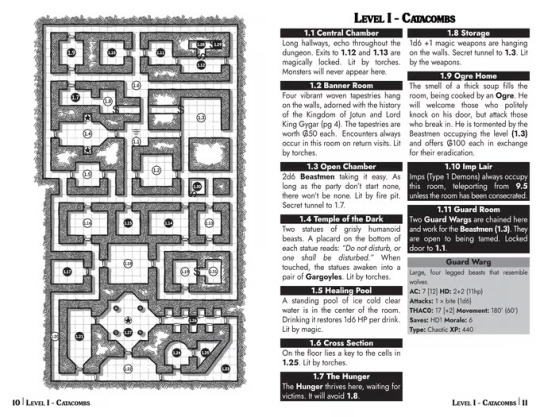
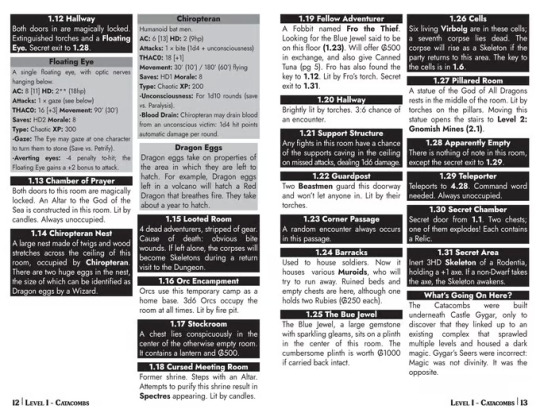
Download a free preview here!
The Ruins of Castle Gygar will be a 64 page, 8.5" x 5.5" black-and-white staple bound zine-style book with laminated soft-touch cover, printed in the USA by Mixam. It'll be on 60lb paper so it'll be nice and thin. We'll be shipping it from the United States, and each order will be hand-packed with love.
The book is written by Onslaught Six and features cover art by Chaoclypse and will be edited by Ennie award winner Roz Leahy. The book currently has all text written and layout conventions established, and awaits editing, a layout pass and (depending on budget) additional art. Then we'll be able to go to printing and distribution.
Thank you so much for your support. We wouldn't be able to keep making TTRPG stuff without you. We sincerely thank each and every one of you who's ever donated to our Kickstarters, or bought our books. Your support is vital to us continuing to make dope shit.
PLEDGE ON KICKSTARTER NOW!
26 notes
·
View notes
Text
Geek Gamers on Youtube is covering our Dungeon Year Journal and how she is using it in 2024.
She does a fantastic deep dive on all the features of the Journal, too!
If you're a designer or solo player, check it out:
youtube
What is the Dungeon Year Journal, you ask? It is our journal for creating one a world, community, dungeon, or anything else you'd like one detail a day for a year!
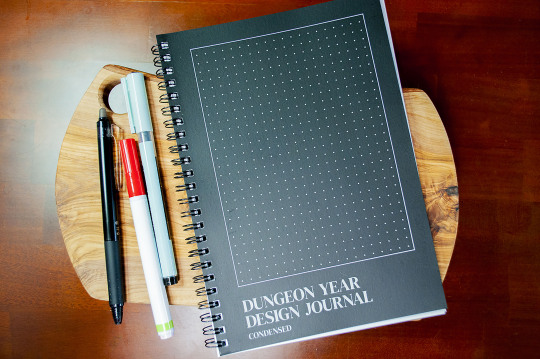
And it comes in two sizes! Condensed, with weekly spreads, and a large A4-sized 204 page journal with a dedicated entry for all 365 days!
#ttrpg#ttrpg design#indie ttrpg#ttrpg community#solo journaling#journaling#notebook#d23#dungeon23#dungeon24#Youtube
82 notes
·
View notes
Text
Ludo-Labo
Running and playing pre-written adventures, I don’t think I always clue in to what makes an encounter effective, not “in the moment”, anyway. I’m too focused on the moment itself to parse why what’s on the page is translating into a good time. After reviewing the text, post-session, one key ingredient seems to be whether or not the text is providing enough information to telegraph danger to players. It’s not something I always do consistently well in my own writing, but it’s something I’m more mindful of lately.
For example, I’ve just completed edits on a hazards table, where players encounter a room full of crates filled with dangerous chemicals in a laboratory setting. Originally, I focused on the hazards themselves, describing the effects of the chemicals, and what happens when the players are already exposed to the danger.
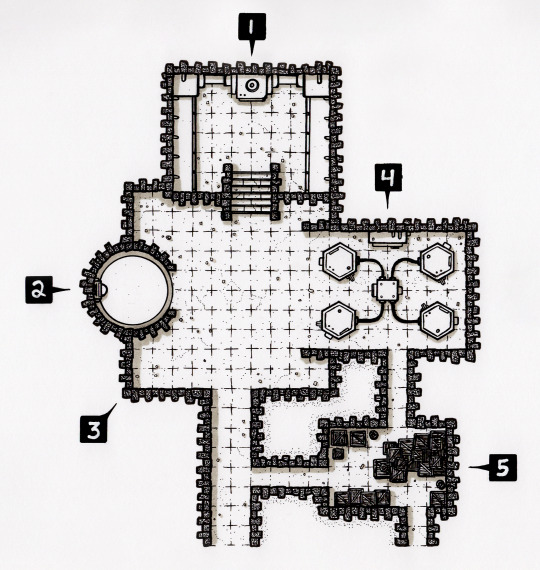
We're talking about room #5 here.
On the second pass, I made sure to include simple details, to alert the players to potential danger, or a way for them to react, or avoid the danger, even if they were unsure of the specific outcome.
Let’s have a look at each.
Chemical Hazards (1D6):
Incendiary Tar: A dark sludge slowly expands, creeping into adjacent rooms. The slightest spark will set the mud ablaze. This one is fairly visual, easy for players to spot. There’s nothing really to tell them that it is tar, or that it is flammable, perhaps an odor could be written into this, to make it clearer. But the fact that the tar expands slowly gives players time to react, even if they do throw a fireball at it.
Explosive Reaction: Chemicals stored here are marked as highly volatile, the slightest impact will cause a violent explosion. Here, the danger is much more sudden, explosions happen fast! Big warning signs filling the room are easy to notice and avoid. Perhaps the players could use this knowledge to their advantage, setting a trap.
Noxious Gases: Spending any time in this room will cause one to become light headed, intense nausea is soon to follow. While not immediately evident, the gradual sickness helps to alert players to a more severe outcome, allowing them the chance to escape the area.
Acid Puddle: Recklessly treading through this room, the soles of one’s boots will be eaten away after a few minutes. This one is probably the least telling, and speaks more to the GM than the players, leaving more work for the GM to make it fair. I’ve not explicitly written what the hazard is here, or how it might be noticed. But the stakes are not as high either. It takes some time for the acid to take effect, and, at worst, they are out of a pair of shoes. Still, I’ll admit, it’s the worst of the bunch.
Oxidizing Vapor: A pungent, yellow cloud fills the air. All metal will rust after a few minutes of exposure. A tell that’s a bit more overt, featuring sight and smell, to alert players in multiple ways. The stakes are higher here, strolling through this room is likely to damage a players armor and weapons, making them less effective overall.
Liquid Nitrogen: A pale mist wisps across the floor. The air becomes colder upon approach. Exposed skin will become frostbitten within seconds of stepping into this room, joints will seize soon after. Pale mist on its own might not be much of a warning, depending on where players encounter it, but given that this is an indoor area, that should put them on alert. If that’s not enough, the addition of increased cold as players approach should make it especially clear that this is not a normal room.
I could probably keep editing forever, but at the moment I’m feeling good with my progress on this kind of thing. Being able to identify that things could be better is a good place to be. I’m willing to bet that it means things will be even better on the next adventure.
I'd love to see some good examples of telegraphed danger in TTRPGs, hit me up with your favorites!
22 notes
·
View notes
Text
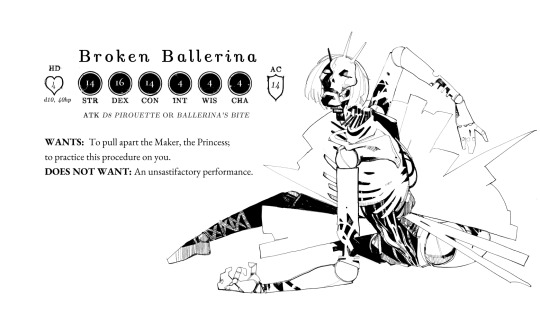
a megadungeon monster from earlier in the year - gotta get back on that d23 train at some point!
118 notes
·
View notes
Text

Room 3: A 4' tall potted shrub sits against the south wall. Some of the leaves have been pinched off. Chewing or smoking a leaf imparts a magical effect:
1. Purple vision for d4 hours
2. +2 save versus Poison for d4 hours
3. Sleep for d4 hours
4. Save or head turns into frog head (actual size)
5. Ultrasensitive hearing for d4 hours
6. Weakness to fire damage for d4 hours
Room 4: A safe sits on the west end of the room. A potion deliberately left to decay inside has filled it with poison gas; save or take 1d6 damage and suffer blindness for the same number of turns. The safe also contains 73 septims, two quartz crystals (5 gp each), a copper wolf amulet (30 gp), a silver amethyst ring shaped like a cat's eye (150 gp), and a Nordic gold coronet with emeralds cut in the shape of Dragon language characters (1,800 gp); they read "I take breath."
Room 5: Bandits' barracks. Bedrolls, supplies for maintaining weapons and armor, empty wine bottles, etc.
Room 6: Chimes attached to south side of north door. Bandit chief Kzarr-kesh's chambers. He is a 3rd level Khajiit fighter with Leather armor, wielding a Steel longsword and a Steel dagger. He is notable for his unflappable joviality and love of contests, though he is no more compassionate than the next brigand. A locked footlocker under his bed contains a scroll of Protection from Undead, a Silver dagger (30 gp), and a stone slab carved with an unlabeled map showing a route from this hideout to Seldren Morobor's lair. He carries the key to the footlocker (and the locked doors in this hideout) on his person, except at night when he puts it on his nightstand.
Room 7: Barren pyramid chamber. Facing the stairs on the west wall is an inscription in Jel reading "One became many". Stairs go down to Room 8.
Room 8: Ring of cracked pillars. It's possible to break them and thus collapse room 8 and everything above it. There is a 1% chance per day of this happening without outside effort at sunrise. Shelves on the walls are full of empty clay jars smelling of sap. An inscription on the west wall in Jel reads "Many become one."
Room 9: Sarcophagus made of stone. It takes a combined Strength score of 22 to move the lid. Unliving things placed inside will have decay reversed but will not be restored to life.
9 notes
·
View notes
Text
youtube
⬆️ watch me attempt to catch up on my room-a-day #dungeon23 megadungeon lol
⬇️ also: the project has a name and we're going to be printing it as both a book and a BIG poster! follow on kickstarter to get notified when the project launches next month!
17 notes
·
View notes
Text

Finished! Here’s the final map.
I never thought I’d get this far, particularly because the 3 friends I started it with had all dropped it by May, but I’m pretty proud of the whole thing. I’ve never done a year-long challenge before.
No rest for the wicked, FIST: JAM Ops IV starts tomorrow, but I’ll be very happy to stop thinking up room descriptions for a little while, and who knows? Perhaps one day I’ll come back to it and make a zine or something to publish.
19 notes
·
View notes
Photo
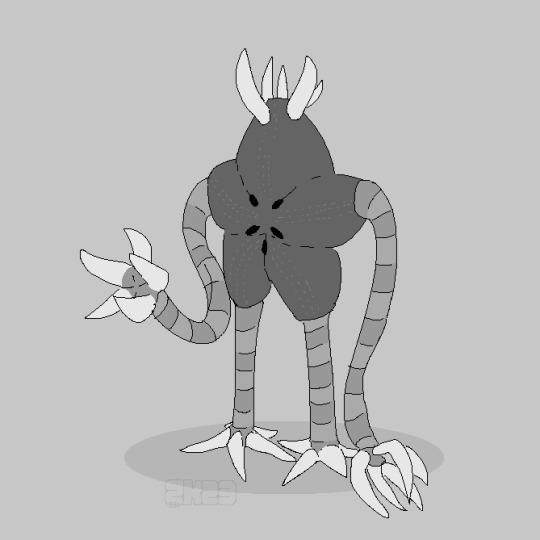
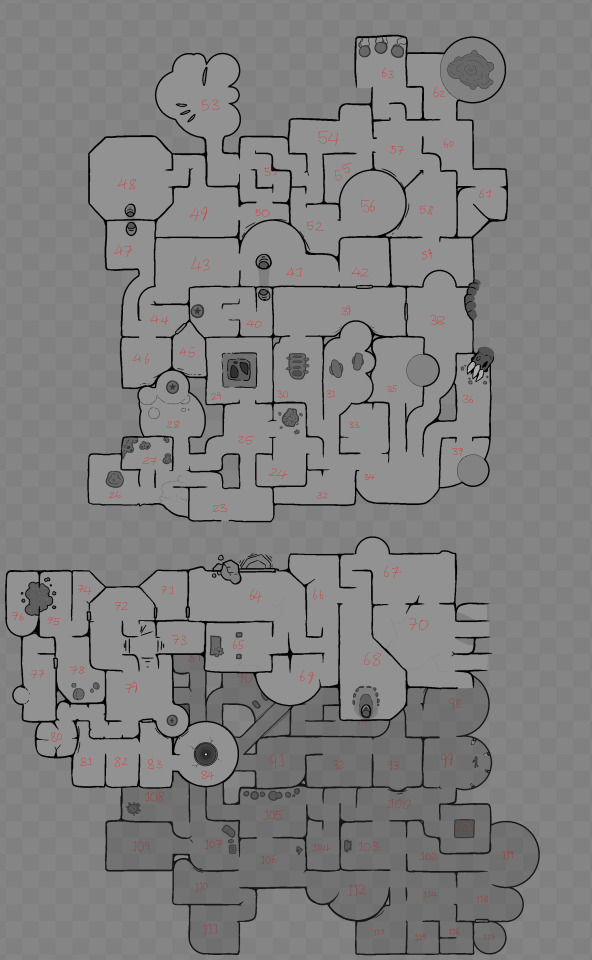
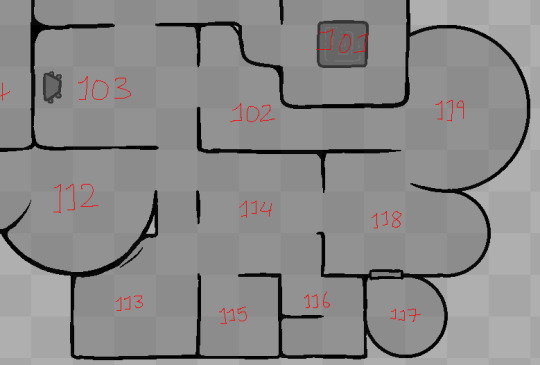
"It looks like what you'd get if someone tried to build a human based off of unconfirmed sightings and only had bits left from the kit they used to make starfish."
Further progress in the Dead City. Next time, I think we'll go somewhere else on this planet, see something else. (1510-12, Dungeon23 113-119)
12 notes
·
View notes
Text
Dungeon 23, Month of September, the Kobold Fortress

13 notes
·
View notes
Text
Dev Pipeline: Determined and #Dungeon23 [Pt. 7]
Anyone reading my blog already knows what happened to my game in 2023: I signed up for the megadungeon challenge. This was going to kill two birds with one stone – and by "two birds" I mean "several dozen interrelated design problems", and by "one stone" I mean "three hundred and sixty five bespoke puzzles".
Joking aside, #dungeon23 showed up at exactly the right time to rescue my game. Having reached the conclusion that procedural generation wasn't going to work, I had instead hit upon the idea that what I needed was more like a "monster manual". Except instead of only monsters, it would provide all sorts of encounters: Traps, puzzles, bizarre architecture, whatever I could think of. The GMs of Determined wouldn't design their own dungeons, they'd just grab my premade rooms and slot them in as needed.
#Dungeon23 offered an obvious extension of the idea: I could arrange those encounters into a single, cohesive megadungeon, and then GMs of Determined wouldn't need to do any prep at all. They would just run my dungeon straight out of the book.
This scheme also allowed me to diegetically address the various exploits and other un-fun gameplay that had cropped up in testing my rules: the dungeon would constitute the entire diegetic reality of Determined – players would start inside it, and never leave, and so I would never need to address the possibility of them accessing any resources except the ones that I had curated for their use.
Over the course of #dungeon23, I refined a lot of the specifics. Different room concepts explored possible versions of certain mechanics, and I often found myself making modifications to the core rules after seeing how a particular room might affect the game as a whole.
In this way, I was also able to push the limits of what seemed to be possible with the system. For instance: I had initially figured that, since I had tied the GM's hands, there was no one who could role-play as NPCs – until a play-tester offered that an NPC might use a table or flow-chart to dictate all of their possible behaviours. A bit "video-gamey", granted, but technically functional, and it allowed me to not only include NPCs, but eventually also quests and even faction play.
By the end of the year, my perspective on both OSR design and Determined had been revolutionized. You can see my tagged #dungeon23 posts if you want some impressions of the whole thing in progress, but for the Dev Pipeline here I'm just going to talk about the evolution of the core rules.
Click here for Part 8
2 notes
·
View notes
Text

Brinefathom Caves Level 6, Week 5
6.45: The Painting Souls
6.46: The Golden Closet: Various rollers, brushes, and other painting implements, all sticky with hot molten gold. The lot is worth 100 gp. Empty.
6.47: The Lake of Gold
6.48: The Unholy Fountain: Grinning devil-face fountain spews unholy water into a basin. Empty.
6.49: The Fascinating Ice
6.50: The Fountain of Youth
6.51: The Tortured Souls
6.52: The Furry Statue: Lifelike statue of a fiendish ape, all covered in dark red fur—even the pedestal and surrounding floor. A creature who touches any furry surface must make a Constitution saving throw or be cursed to also sprout dark-red fur all over their body (no game effect) until the curse is removed. Empty.
6.53: The Bloody Chains: Southern slab door connected to four chains, which are strung through the ceiling and hang down in a east-west line in the center of the room. Their dangling ends end in sharp hooks coated with old dried blood. Slab door only opens when all chains are embedded in creatures’ flesh and pulled, dealing piercing damage—if each chain does not deal damage, the door will not open, no matter how hard the chains are otherwise pulled. Empty.
6.54: The Chains of Prophecy
17 notes
·
View notes
Text
#Lore24 Weekly Post (1/52) - The Kilogem Accord
Sooo #lore24 is an annual challenge inspired by last year's #dungeon23 challenge, the major difference being that you regularly publish daily (or weekly) details about a world/setting you're working on, instead of creating aspects of a dungeon. Although I've been bad about consistency, I'm still working on this and you can see all my weekly posts on my bearblog--lucky tumblr though, I'm also going to post my weekly #lore24 entries here just to spread the word about the several settings I'm working on 😎
KILOGEM
Named after the KILOGEM ACCORD, a society of sapiosentient AI machines (magichines) that have inherited the remains of the Sol system. Humanity’s first contact experience occurs during one of the more turbulent periods of Earth’s history, which caused its eventual doom. Prescient techno-wizards (arcane mechanists) create a failsafe program from alien technological remains after decrypting messages from precursor entities, resulting in the creation of magichines. These magichines are sapiosentient and have been tasked with carrying the legacy and lessons of humanity, as well as supporting and protecting the existence of other sentient beings (including other magichines).
THE KILOGEM ACCORD
Magichines are sapiosentient, paracausal machine entities that were created by late human Arcane Mechanists, who were seeking to construct AI entities with magic, and reverse-engineered precursor technology. Although their needs are minimal, magichines appreciate the opportunity to upgrade their hardware and software modules that allow them to further express their personhood -- there are gastro-culinary modules, sleep modules, hormonal-gland system modules, and more are available and frequently used by many magichines.
Magichines are functionally immortal, as long as they are not subject to extreme conditions for too long (they will not survive being launched into the sun, or a large enough explosion lol). Magichines are at risk of existential decline, however, where cognitive and behavioral issues worsen or start appearing after a century of operation, with few exceptions--the remaining being either lucky enough to not experience this decline or unlucky enough to experience signs of the decline earlier than the century mark.
This issue is easily solved by adjusting their software and hardware, thankfully. There have been rare incidents where resetting has caused the issue to worsen, or where it has done little to help a magichine in decline. Additionally, resetting is a resource-intensive operation that requires access to at least some capable level of techno-medical care. Some magichines have self-terminated, or their operational cores have deteriorated past the point of recovery, after not receiving care/resetting operations on time.
Mortality has been a surprisingly captivating discussion for magichines over the centuries. Technically, as long as a magichine's initial mind is intact and stored safely, they can functionally exist for a long, long time. However, there are a variety of reasons that may end a magichine's existence, that don't necessarily revolve around their physical destruction.
One important right that magichines have is the freedom to actively choose existence. Although not often, there are magichines who refuse medical intervention after signs of decline start affecting their bodies and minds -- be that choice a result of apathy, sadness, acceptance, or exhaustion. In other cases, magichines (for whatever reason) go missing or do not contact other magichines and simply do not have access the necessary procedures/resources necessary to reset themselves.
In the spirit of respecting a magichine's autonomy, magichines who do not actively choose to reset are left to any consequences that may result of that choice. A growing concern that supports this policy regarding the magichine population is the marginally increasing scarcity of materials necessary to upkeep magichines physical forms, over time. This has also sparked investment in voyages outside of the solar system for resources.
IDENTITY
Magichine naming conventions are a little bit complicated.
Magichine's names consist of two parts: the alphabetical name that they choose after creation, and the numerical name that denotes their version state, their current home/base of operations, and their creation/origin locale.
For example, let's look at CARBON-2-17M-1E
CARBON: This is the chosen name of this magichine, used frequently when in the company of others
2: This is the version state of the magichine, which reflects how many times the magichine has been reformatted. Although it is also frequently used as a measure of age/length of existence, there are a few magichines whose version state numbers are deceiving. For example, some magichines do not fall in the median time cycle point for reformatting (typically around a century of operation). Their version state may mean that they've only reformatted once or twice after 500 years of operating--or in that same period, their version state may reveal that they've had to reformat a dozen times.
17M: These alphanumerical characters reflect the magichine's current home or frequented base of operations. Like the alphanumeric characters used for their locale of origin, these characters reflect a manufacturing location and a more broader locale, such as a planet, ringworld, moon, or space station. In this case, 17 denotes that this is manufacturing location #17 on Mars.
1E: These characters denote a magichine's region and greater locale within the solar system. Carbon, in this case, comes from region #1 meaning the megacity of Sunset City--located on planet Earth.
SOCIETY - THE KILOGEM ACCORD
Magichines are marvelous examples of individual autonomy and endurance. However, fortunately, they were created to crave and seek out social interaction with others--large swathes of magichine society are dedicated to the support of individual magichines, and towards facilitating interaction amongst each other.
Several semi-subliminal directives underlie these sapiosentient beings:
magichine society must be dedicated to the understanding, protection, and support of individual and communal groups of magichines
magichine society is dedicated towards the preservation of knowledge and understanding of humanity
magichine society is dedicated towards that same obligation of understanding and preservation for other similar sapiosentient beings
magichine society must respect, support, and protect the autonomy of other sapiosentient beings, as well as magichines
These directives are not the only ones that exist--however, they are the most important ones established. Some numerous more sub-directives and amendments build off core concepts from these prime directives--policies that have been endlessly debated and voted upon by the entirety of magichine society (at least--those that have existed at the time of the election).
ECONOMICS
MATERIALS
Metals, alloys, polymeric substances, semiconductors, rare earth metals, nanomaterials, sunglass, self-healing materials, and bio-organic materials are all necessary material components used for the magichine economy.
GATHERING
The Collective's resource-gathering operations are almost entirely done via automatons, overseen by magichines. Resources come from mining projects (on planets, on asteroids), gas extractions, moisture collection, recycling, and scavenging.
Solar power makes up most of the collective's energy resource, due to the efficient and secure properties of sunglass. Nuclear fusion also produces a significant amount of energy for the Collective, and recent research has been made into making more efficient and compact fusion reactors.
PRODUCTION
Most of the infrastructure, products, equipment, tools, and complex materials are produced via omni-printers (a variety of personal and industrial-grade 3D printers). Personal use printers are small enough to fit in a magichine's home unit, while a dozen industrial printers fit comfortably inside of a large factory depot.
Unique, delicate, and niche items are also commonly produced "from scratch" by magichines, and these typically involve little to no use of omni-printers in their creation.
STORAGE
Storage depots and archives are important to the livelihood of the Kilogem magichines. Depots and warehouses provide anything and everything a magichine requires to live, while archives are devoted to the preservation and development of knowledge--of magichines, and of humans.
DISTRIBUTION
Depots and warehouses doubly function as distribution centers, to make the logistics more efficient and easily accessible. Automatons frequently deliver raw and manufactured products on behalf of these facilities, and the process overall is managed and overseen by magichines.
Distribution centers work closely in conjunction with planning committees and councils due to the nature of the economy at large.
RESEARCH
Universities still exist in the future, however, they are not the only places of learning and research. Independent laboratories and libraries, be they corporate or from an autonomous organization, operate similarly to the universities of old (as research institutions).
Autonomous libraries are home to prime archives, which are collections of data stored in subspace that succinctly detail the entirety of remains of human existence and history, as well as the most current history of the magichines.
PLANNING
With autonomy being a key characteristic of magichine society, economies are planned at the local, regional, planetary, and collective levels. This is done for a variety of reasons: for safety and redundancy purposes, for efficiency, reactivity, and for supporting independent/autonomous capabilities of groups of magichines. Democratic agency, input, and autonomy are the main motives for planning most of the Collective's economy.
#lore24#dungeon23#worldbuilding#ttrpg#solo ttrpg#writing#lore#lore building#scifi#sci fi and fantasy
2 notes
·
View notes
Text
Floor 12 Summary
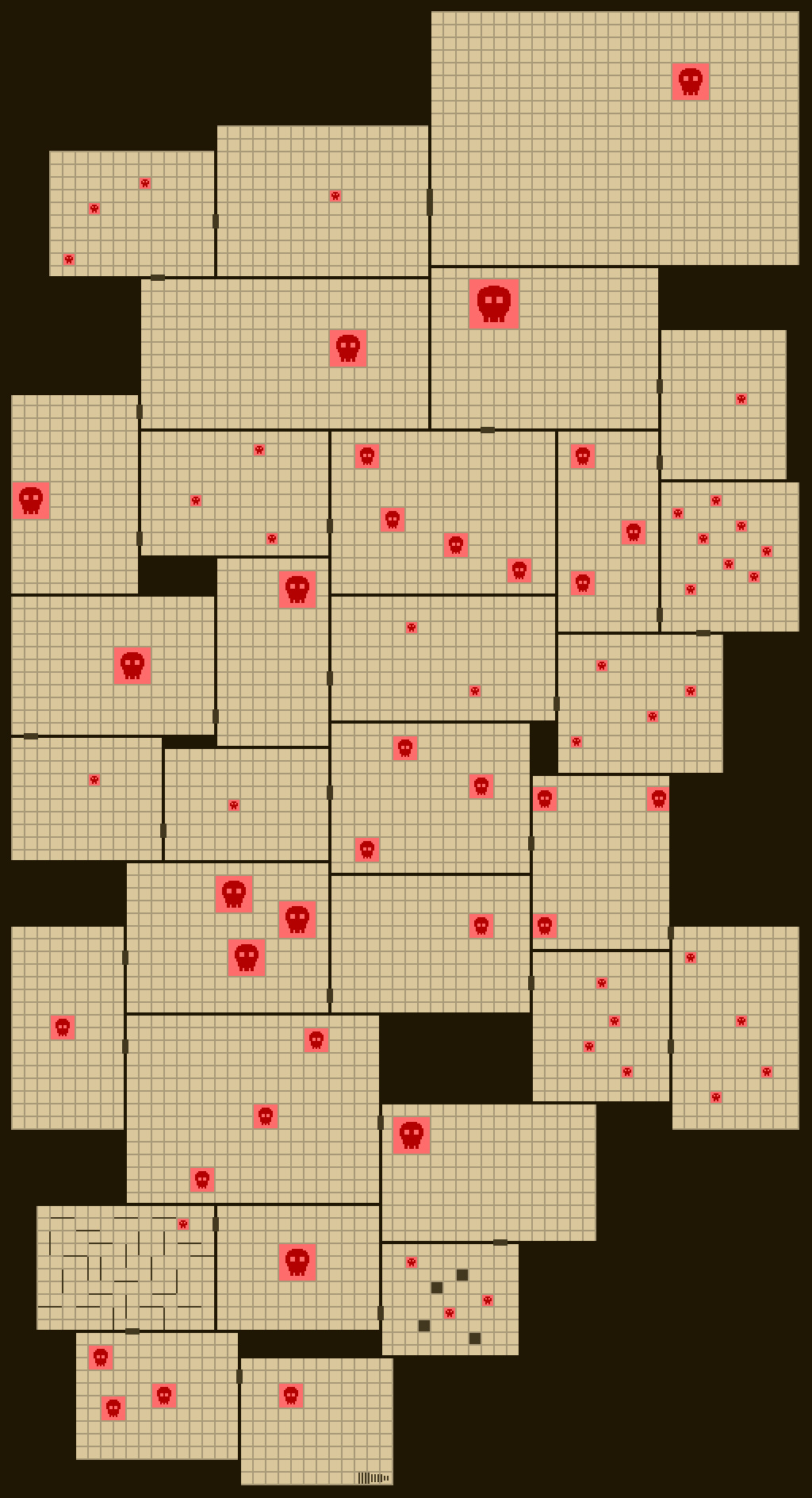
letting out a roar of anguish as it is defeated, the dragon's body freezes into pure, inanimate gold. as it dies, the dungeon itself shakes and heaves, and in a blinding flash of light, the entire structure vanishes. all that remains are the party, an enormous wound in the earth, and this golden monument to their victory.
through a dozen floors, over three hundred rooms, and hundreds of enemies, the party has finally vanquished the megadungeon.
#dungeon23#pathfinder 2e#happy new year's eve! still december in my time zone anyways haha#this has been a ton of fun#and while i don't intend to do this specifically again here's to a new year full of good gaming
5 notes
·
View notes
Text
Brute Force Adventure Writing?
I’ve found success lately by writing my 1D6 tables as 1D8 tables, then cutting the two least interesting options. Even if I write just one extra option and make a cut, it tends to make a stronger encounter table. A 1D4 table? Write five options, review and cut the most boring or repetitive one. Write lots, keep what’s best. Is this brute force adventure writing? Or like just, normal editing? I don’t know. I’m not a professional. But it works.
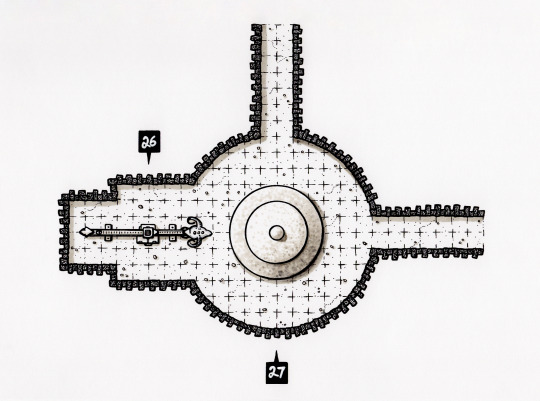
In one of my latest dungeon rooms, players can encounter a giant urn full of nanomachines. The Nanites can combine into several forms. I went for a 1D4 table in this case, wrote five options, then cut one.
Nanomachine Gestalts
1. Statuesque Humanoid: From a distance, the swarm appears human. Tall and graceful, gleaming with reflected light. Up close, the figure takes on an alien appearance, its proportions exaggerated, its face grotesque.
2. Kaleidoscopic Lattice: Arrays of Nanomachines chain together, rapidly filling the room with a complex matrix of crushing fractals. Passage through the area becomes increasingly dangerous.
3. Electric Amoeba: An amorphous shape, its iridescent volume warps and quivers in all directions. Appendages appear and disappear as it blindly probes the room.
4. Monolithic Geometry: Cubes and other angular shapes form a mass of intersecting surfaces, reflecting the world around it. New structures erupt like animated pyrite, extending to unexplored passageways, while trailing offshoots reconstitute into the primary locus.
5. Simulacrum: The Nanomachines appear as a cloud of iridescent dust. Several are inhaled by a member of the adventure party, entering their bloodstream and brain. The remaining Nanites will fill the room, creating a space based on the adventurer’s memory, for all to see.
I ended up cutting #3 from the available options. It was too similar to option #4 in form and function. Plus I wanted to push the “machine” aspect in nanomachine. Really, #3 inspired me to write #4 – a classic blob monster, but more mechanical? Of course. Giving the encounter a more organic bent could have been interesting? But I thought the humanoid form in option #1 filled that niche well enough. Given every other option, #3 didn’t have a lot going for it. Overall, I think the table is stronger without it.
And I just want to say…
Why’s it gotta be so hot? I’m so unproductive in the summer. Any amount of heat seems to sap my motivation. So, a perfect time of year to wrap up a mega-dungeon. And yet, progress has been made. I just cracked 200 pages on my latest project, The Electric Triptych of the Tetric Necromancer. By the end of next month I should have all 12 (out of 12) areas laid out and edited. After that, I’ll want to draft an introduction, a timeline of events, a few adventure hooks and such, but the entire dungeon will be playable from start to finish. That’s something.
Stay cool, people.
#ttrpg#dungeon23#ttrpg maps#dnd#indie ttrpg#ttrpgs#osr#drawing#ttrpg art#inkdrawing#writing#creative writing
16 notes
·
View notes